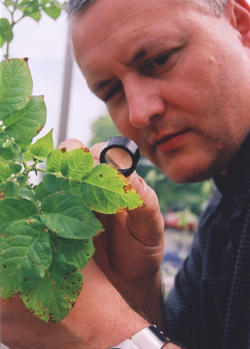
Seed potato growers are being warned to treat with care virus risk warnings based purely on results of aphid catches in water traps operated by CSL. Catching high numbers of aphids that realistically pose little or no risk to potato crops can skew results of the virus index and trigger unnecessary spray warnings, according to Dr Andy Evans of SAC.
Dr Evans advocates growers use the water trap results, available free for BPC levy payers on the internet (http://aphmon.csl.gov.uk), as an early warning for when the key virus carriers - the Peach Potato Aphid, Buckthorn-Potato Aphid and Potato Aphid - are active in their area. "There's really no substitute for getting in amongst the crop and regularly inspecting for aphids," he says.
"Increasingly we are advising growers to wait until they physically see aphids in their seed crops, before they start the spray programme," reports Dr Evans. "In the past we have been too liberal with aphid warnings, based on aphid sightings possibly miles from a growers' crop. This new approach does place greater onus on growers to inspect crops and treat accordingly."
Although levels of some viruses in Scottish seed are reported to have risen in the past two seasons, Dr Evans does not believe this is a result of any move towards a responsive control strategy, instead of prophylactic insecticide treatments,
However, with the wait-and-see policy Dr Evans advises growers will need to adopt a robust and fast acting insecticide programme to tackle any build-up in aphid numbers. This is absolutely crucial in the early stages of crop growth, when plants are most susceptible to virus transmission.
Dr Evans advises growers to start programmes with a mix such as Plenum plus Hallmark Zeon, which will give a quick knockdown of virus carriers and provide repellent anti-feeding activity, as well as control of any overwintered insecticide resistant Myzus persicae (Peach Potato Aphid).
Starting from a clean aphid-free base, he believes using a knockdown and repellent Hallmark Zeon or Dovetail, for example, interspersed with a longer lasting and systemic insecticide, such as Plenum plus Hallmark Zeon, will give the required two-pronged approach to minimise resistance build up and risk of virus transmission.
Yorkshire specialist seed potato grower, Mark Megginson, follows Dr Evans' aphid control advice through his local SAC advisor, John Sarrup. Producing 45 hectares of quality seed for Ibbotson's Potatoes, virus and blight control is a high priority.
"Most of the seed potato crop is growing at over 800 feet, so the aphid pressure is inherently much lower," according to Mr Megginson. "We prioritise insecticide mixes with the blight sprays from the initial stages of crop growth, with a Plenum plus Hallmark Zeon tank mix early on."
The seed crops at Cot Nab Farm, Bishop Wilton may receive between six and eight insecticide applications over the course of the season to minimise any virus risk. Hallmark Zeon is used alongside Plenum for two or three applications, interspersed with Dovetail. "We are looking to keep aphids out of the crop, as well as avoid any build up or resistance issues," adds Mr Megginson.
One of the key challenges in recent seasons has been big leaf canopies on crops such as Estima and a new variety, Markie. This season he plans to use the new Syngenta Potato Nozzle, with its angled spray pattern to improve crop penetration. New research from Silsoe has also shown the combination of alternating nozzles to face forwards and backwards along the spray boom, along with the variable pressure design, could significantly reduce drift issues in exposed fields.
